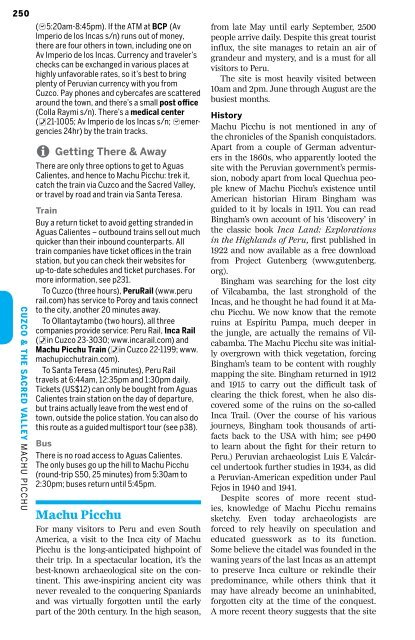peru-8-cuzco-sacred-valley
You also want an ePaper? Increase the reach of your titles
YUMPU automatically turns print PDFs into web optimized ePapers that Google loves.
250<br />
Cuzco & the Sacred Valley 8 M AC H U P I C C H U & T H E I N C A T R A I L<br />
(h5:20am-8:45pm). If the ATM at BCP (Av<br />
Imperio de los Incas s/n) runs out of money,<br />
there are four others in town, including one on<br />
Av Imperio de los Incas. Currency and traveler’s<br />
checks can be exchanged in various places at<br />
highly unfavorable rates, so it’s best to bring<br />
plenty of Peruvian currency with you from<br />
Cuzco. Pay phones and cybercafes are scattered<br />
around the town, and there’s a small post office<br />
(Colla Raymi s/n). There’s a medical center<br />
(%21-1005; Av Imperio de los Incas s/n; hemergencies<br />
24hr) by the train tracks.<br />
8 Getting There & Away<br />
There are only three options to get to Aguas<br />
Calientes, and hence to Machu Picchu: trek it,<br />
catch the train via Cuzco and the Sacred Valley,<br />
or travel by road and train via Santa Teresa.<br />
Train<br />
Buy a return ticket to avoid getting stranded in<br />
Aguas Calientes – outbound trains sell out much<br />
quicker than their inbound counterparts. All<br />
train companies have ticket offices in the train<br />
station, but you can check their websites for<br />
up-to-date schedules and ticket purchases. For<br />
more information, see p231.<br />
To Cuzco (three hours), PeruRail (www.<strong>peru</strong><br />
rail.com) has service to Poroy and taxis connect<br />
to the city, another 20 minutes away.<br />
To Ollantaytambo (two hours), all three<br />
companies provide service: Peru Rail, Inca Rail<br />
(%in Cuzco 23-3030; www.incarail.com) and<br />
Machu Picchu Train (%in Cuzco 22-1199; www.<br />
machupicchutrain.com).<br />
To Santa Teresa (45 minutes), Peru Rail<br />
travels at 6:44am, 12:35pm and 1:30pm daily.<br />
Tickets (US$12) can only be bought from Aguas<br />
Calientes train station on the day of departure,<br />
but trains actually leave from the west end of<br />
town, outside the police station. You can also do<br />
this route as a guided multisport tour (see p38).<br />
Bus<br />
There is no road access to Aguas Calientes.<br />
The only buses go up the hill to Machu Picchu<br />
(round-trip S50, 25 minutes) from 5:30am to<br />
2:30pm; buses return until 5:45pm.<br />
Machu Picchu<br />
For many visitors to Peru and even South<br />
America, a visit to the Inca city of Machu<br />
Picchu is the long-anticipated highpoint of<br />
their trip. In a spectacular location, it’s the<br />
best-known archaeological site on the continent.<br />
This awe-inspiring ancient city was<br />
never revealed to the conquering Spaniards<br />
and was virtually forgotten until the early<br />
part of the 20th century. In the high season,<br />
from late May until early September, 2500<br />
people arrive daily. Despite this great tourist<br />
influx, the site manages to retain an air of<br />
grandeur and mystery, and is a must for all<br />
visitors to Peru.<br />
The site is most heavily visited between<br />
10am and 2pm. June through August are the<br />
busiest months.<br />
History<br />
Machu Picchu is not mentioned in any of<br />
the chronicles of the Spanish conquistadors.<br />
Apart from a couple of German adventurers<br />
in the 1860s, who apparently looted the<br />
site with the Peruvian government’s permission,<br />
nobody apart from local Quechua people<br />
knew of Machu Picchu’s existence until<br />
American historian Hiram Bingham was<br />
guided to it by locals in 1911. You can read<br />
Bingham’s own account of his ‘discovery’ in<br />
the classic book Inca Land: Explorations<br />
in the Highlands of Peru, first published in<br />
1922 and now available as a free download<br />
from Project Gutenberg (www.gutenberg.<br />
org).<br />
Bingham was searching for the lost city<br />
of Vilcabamba, the last stronghold of the<br />
Incas, and he thought he had found it at Machu<br />
Picchu. We now know that the remote<br />
ruins at Espíritu Pampa, much deeper in<br />
the jungle, are actually the remains of Vilcabamba.<br />
The Machu Picchu site was initially<br />
overgrown with thick vegetation, forcing<br />
Bingham’s team to be content with roughly<br />
mapping the site. Bingham returned in 1912<br />
and 1915 to carry out the difficult task of<br />
clearing the thick forest, when he also discovered<br />
some of the ruins on the so-called<br />
Inca Trail. (Over the course of his various<br />
journeys, Bingham took thousands of artifacts<br />
back to the USA with him; see p490<br />
to learn about the fight for their return to<br />
Peru.) Peruvian archaeologist Luis E Valcárcel<br />
undertook further studies in 1934, as did<br />
a Peruvian-American expedition under Paul<br />
Fejos in 1940 and 1941.<br />
Despite scores of more recent studies,<br />
knowledge of Machu Picchu remains<br />
sketchy. Even today archaeologists are<br />
forced to rely heavily on speculation and<br />
educated guesswork as to its function.<br />
Some believe the citadel was founded in the<br />
waning years of the last Incas as an attempt<br />
to preserve Inca culture or rekindle their<br />
predominance, while others think that it<br />
may have already become an uninhabited,<br />
forgotten city at the time of the conquest.<br />
A more recent theory suggests that the site


